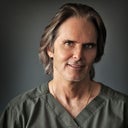Your nose has strong "projection," which means it comes out forward away from your face strongly. The bridge comes down to match the tip of your nose. If the tip is moved back closer to your face, and the bridge is left where it is, well, it just wouldn't look like a nose, with the bridge sticking out well beyond the tip.





